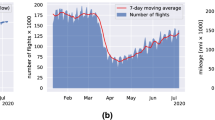Abstract
We provide an automatic algorithm proceeding from raw automatic identification system (AIS) data, through filters, highlighting vessel types, cargo, or regions, to discrete transport patterns, describing the geographic, directional, and total volume of transport. The designed algorithm automatically detects major ports or zones, where vessels are stationary and close to land, and groups them hierarchically in order to determine the end nodes in a transport matrix. In conjunction with vessel type, size, and draught information, the transport matrix is then used to compile transported tonnage and vessel count, to display as trade flows between nodes. In addition, by clicking on individual routes, the system also provides quantitative details, such as summed tonnage, or passing vessel counts. We use trades carried out by VLCC and Supramax bulk carriers as examples to demonstrate the results. The contribution of the research is threefold. First, we use AIS data to aggregate “real-time” trade flows. This substantially reduces latency from the traditional way of mapping flows and generating trade statistics. Second, the ability to visualize changes in seasonal or regional trading patterns enables economists and policy makers to monitor changes at a macro level. Finally, the ability to dripple down to the individual ship level allows commercial traders to monitor vessels or company performances, which provides valuable information in trading and decision-making.
Similar content being viewed by others
Notes
As mentioned in the introduction, the baltic dry index (BDI) has been inadequately used by financial practitioners as an indicator for OECD Industrial Production; however, the correlation between the two has been shown to be below 20% over a thirty-year period (Patterson 2010).
References
Andrienko, N., and G. Andrienko. 2012. Visual analytics of movement: An overview of methods, tools and procedures. Information Visualization 12 (1): 3–24.
Bentley, J. L. 1975. Multidimensional binary search trees used for associative searching. Commun. ACM 18, 9 (September 1975), 509-517. doi:10.1145/361002.361007 http://doi.acm.org/10.1145/361002.361007.
Bremm, S., T. von Landesberger, G. Andrienko and N. Andrienko. 2011. Interactive analysis of object group changes over time. In Proceedings of the international workshop on visual analytics, eds. S. Miksch and G. Santucci, 41–44. Bergen, Norway: The Eurographics Association.
Daae Lampe, O., J. Kehrer, and H. Hauser. 2010. Visual analysis of multivariate movement data using interactive difference views. In Proceedings of International Workshop on Vision, Modeling and Visualization, eds. A. Kolb, R. Koch and C. Rezk-Salama, 315–322. Siegen, Germany: The Eurographics Association.
Dickerson, M., D. Eppstein, M. T. Goodrich, and J. Y. Meng. 2003. Confluent drawings: Visualizing non-planar diagrams in a planar way. In: International Symposium on Graph Drawing. s.l.
Fearnleys. 2002. Annual Review. Oslo: Fearnleys.
Gross, D. 2003. The shipping news. The best economic indicator you’ve never heard of. http://www.slate.com/articles/business/moneybox/2003/10/the_shipping_news.2.html.
Holten, D. 2006. Hierarchical edge bundles: Visualization of adjacency relations in hierarchical data. IEEE Transactions on Visualization on Computer Graphics 12 (5): 741–748.
Karakitsos, E., and L. Varnavides. 2014. Maritime economics: A macroeconomic approach. London: Palgrave Macmillan.
Maurer, A. and C. Degain. 2010. Globalization and trade flows: what you see is not what you get! WTO Economic research and statistics division working paper ERSD-2010-12.
Mountain, D. 2005. Visualizing, querying and summarizing individual spatio-temporal behaviour. In Exploring geovisualization, ed. J. Dykes, A.M. MacEachren, and M. Kraak, 181–200. London: Elsevier Ltd.
Nossum, B. 1996. The evolution of dry bulk shipping 1945–1990. Oslo: Birger Nossum.
Patterson, L. 2010. Marine capital monthly report, July 2010.
Phan, D., L. Xiao, R. Yeh, P. Hanrahan, and T. Winograd. 2005. Flow map layout. In proceedings of the IEEE symposium on information visualization, ed. J. S. Matt Ward, 219–224. Washington DC, USA: IEEE Computer Society.
Tominski, C., H. Schumann, G. Andrienko, and N. Andrienko. 2012. Stacking-based visualization of trajectory attribute data. IEEE Transactions on Visualization and Computer Graphics 18 (12): 2565–2574.
Ubøe, J., J. Andersson, K. Jørnsten, and S.P. Strandenes. 2009. Modelling freight markets for coal. Maritime Economics and Logistics 11: 289–301.
Willems, N., W. van Hage, G. de Vries, J. Janssens, and V. Malaisé. 2010. An integrated approach for visual analysis of a multisource moving objects knowledge base. International Journal of Geographical Information Science 24: 1543–1558.
Willems, N., H. van de Wetering, and J. van Wijk. 2009. Visualization of vessel movements. Computer Graphics Forum 28 (3): 959–966.
Wood, J., and J. Dykes. 2008. Spatially ordered treemaps. IEEE Transactions on Visualization and Computer Graphics 14 (6): 1348–1355.
Wörner, M. and T. Ertl. 2012. Visual analysis of public transport vehicle movement. In Proceedings of the international workshop on visual analytics (EuroVA 2012), 79–83. Vienna, Austria: Eurographics Association.
Acknowledgements
This research was funded by the Research Council of Norway as part of the project: “Mapping vessel behaviour and cargo flows” (CARGOMAP: project no. 239104).
Author information
Authors and Affiliations
Corresponding author
Rights and permissions
About this article
Cite this article
Jia, H., Lampe, O.D., Solteszova, V. et al. An automatic algorithm for generating seaborne transport pattern maps based on AIS. Marit Econ Logist 19, 619–630 (2017). https://doi.org/10.1057/s41278-017-0075-7
Published:
Issue Date:
DOI: https://doi.org/10.1057/s41278-017-0075-7











